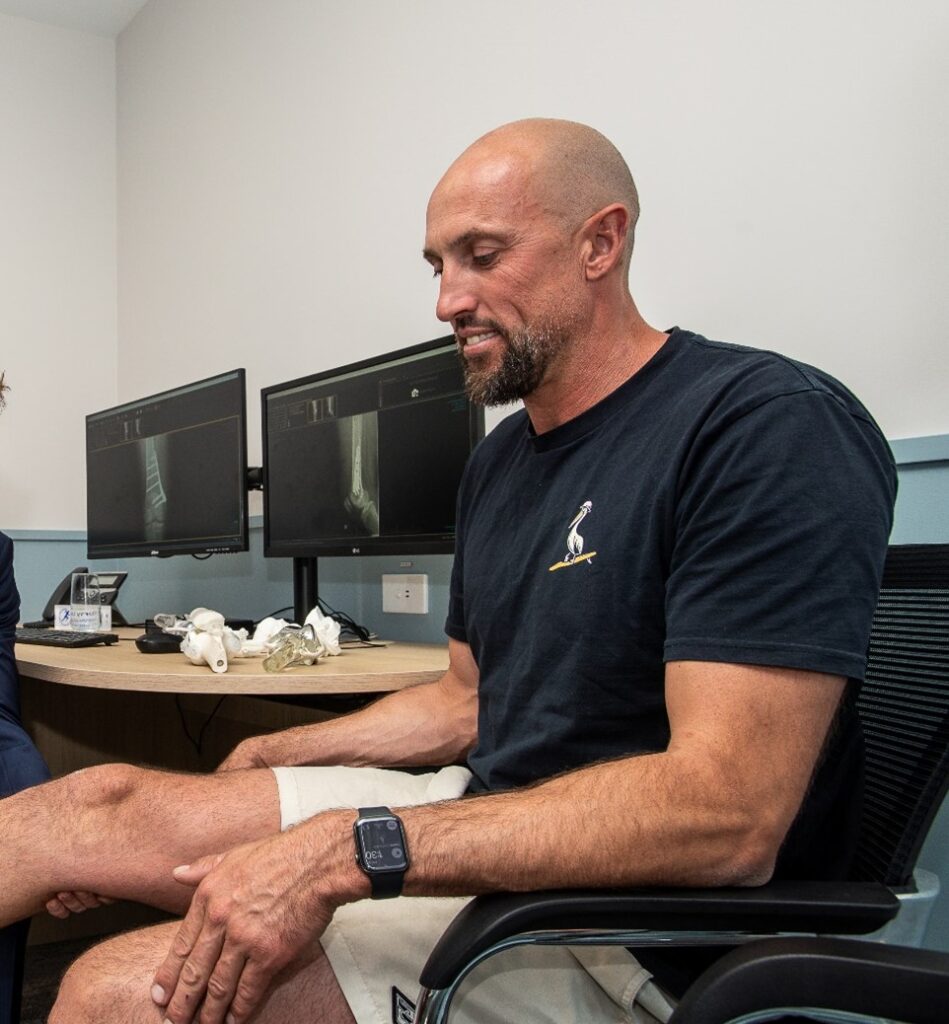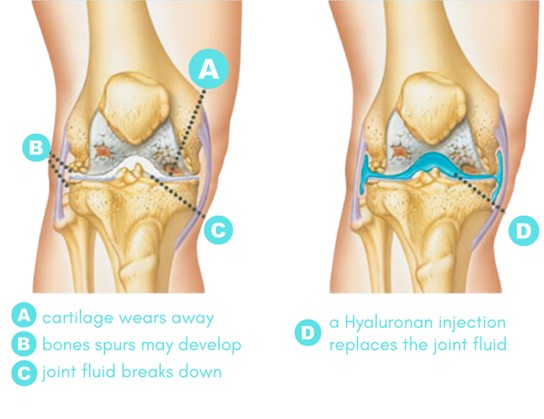Joint Injections For Arthritis Pain Relief
Managing arthritis involves a comprehensive plan that includes various treatment methods and approaches. These may include lifestyle changes such as diet, exercise and cold & heat therapy along with physiotherapy; oral medications; topical treatments; and joint injections for acutely painful, inflamed joints.
In the following sections, we will explore the function of CORTICOSTEROID INJECTIONS and HYALURONIC ACID INJECTIONS in helping to relieve arthritic pain and improve mobility for those suffering from arthritis.
CORTICOSTEROID INJECTIONS

Corticosteroid injections, such as Celestone Chronodose (Betamethasone sodium phosphate/betamethasone acetate), are medications used to relieve inflammation and pain in conditions like arthritis. These injections deliver a powerful anti-inflammatory agent directly into the affected area, providing relief from pain and swelling.
The corticosteroid medication reduces inflammation in the joint, helping to alleviate pain and improve function. This is particularly beneficial for individuals with arthritis, where joint inflammation is a common symptom.
- Quick pain Relief: Corticosteroid injections can provide rapid relief from pain and inflammation, usually lasting about a month. An extended-release version may provide relief for up to three months for knee osteoarthritis.
- Temporary Effects: Repeated injections can cause cartilage deterioration and weaken surrounding tendons and ligaments. Temporary pain flare-ups can also occur in the injected joint but should subside within 48 hours
Cortisone injections are suitable for individuals with severe joint pain or inflammation requiring rapid, temporary relief. The effectiveness and duration of pain relief can vary from person to person. It is essential to follow Dr Martin’s or your healthcare provider’s guidance regarding the frequency and timing of cortisone injections for optimal management of your condition. While cortisone injections can significantly relieve pain and inflammation, they are often part of a broader treatment plan that includes physiotherapy, rest, and lifestyle modifications.
The cortisone injection is typically performed by a qualified healthcare professional, such as a rheumatologist or orthopaedic surgeon. Dr Martin may refer his patients to an experienced radiologist to perform the procedure using ultrasound guidance for precision.
Preparation:
- Ultrasound Scanning – The radiologist uses ultrasound scanning to locate the exact area for the injection and determine the best approach. This ensures the cortisone is delivered precisely where needed.
- Aseptic Conditions – The procedure is conducted under aseptic conditions to prevent infection. The skin over the injection site is cleaned thoroughly.
Procedure:
- Injection – The radiologist uses a thin needle to inject the cortisone directly into the target area. The use of ultrasound guidance helps position the needle accurately.
- Duration: The procedure typically takes about 30 minutes, but patients should allocate around 1 hour from start to finish to account for preparation and post-procedure care.
- Bleeding: Minimal bleeding is expected. A small dressing is applied to the injection site after the needle is removed.
Post-Procedure:
- Immediate Comfort: Most patients feel comfortable immediately after the injection and can leave the clinic shortly after the procedure.
- Resuming Activities: Patients may resume light activities as soon as they feel comfortable, which is usually immediately post-procedure. Strenuous activities, however, should be avoided for a few days to ensure optimal healing.
Cortisone injections can be an effective way to reduce inflammation and provide temporary pain relief for joint pain, particularly in conditions like arthritis. They are however, not a cure and may have potential side effects with repeated use. Patients should discuss the benefits and risks of cortisone injections with Dr Martin to determine if they are an appropriate treatment option.
HYALURONIC ACID INJECTIONS (VISCOSUPPLEMENTATION)
Viscosupplementation is a procedure in which synthetic hyaluronic acid is injected into a joint affected by arthritis and pain. Hyaluronic acid is a substance naturally found in the synovial fluid of your joints. In some people, this natural hyaluronic acid becomes thinner, losing its ability to protect the joint, which causes pain. Injecting hyaluronan into the joint can help to lubricate and cushion it, potentially providing relief from pain and improving mobility.
Common hyaluronic acid injection brands include Monovisc, Synvisc, and Durolane.
Hyaluronan injections supplement the natural hyaluronic acid in your joints, aiming to enhance the viscosity and elasticity of the joint fluid. This can help to reduce pain, improve joint function, and delay the need for more invasive treatments like surgery.
- Pain Relief: Hyaluronan may help reduce joint pain, especially in cases of osteoarthritis.
- Improved Mobility: By enhancing the lubrication and cushioning of the joint, hyaluronan can help improve movement and flexibility.
- Non-Surgical Option: Viscosupplementation is a minimally invasive procedure, providing an alternative to surgical interventions.
Hyaluronan injections might be suitable for individuals with mild to moderate osteoarthritis who have not responded well to other treatments like pain medications, physiotherapy, or corticosteroid injections. It can also be part of a broader treatment plan that includes lifestyle modifications and physiotherapy exercises.
The knee is the most common joint treated with hyaluronic acid injections. Treatment can be administered in both knees simultaneously and at different times, depending on individual requirements. Hyaluronic acid injections can also be used off-label for shoulder, hip, and ankle arthritis pain.
Preparation for Treatment
A pre-injection appointment is required to ensure suitability. During this appointment, Dr Martin will review your medical history, including any allergies or prior drug interactions, and conduct a physical examination. You may be asked to undergo several tests to ensure that the injections are suitable.
You should inform Dr Martin if you take aspirin, anti-inflammatory, or blood-thinning medications, as these can interfere with the injection’s effectiveness. If there is fluid build-up, joint effusion should be treated first before receiving this treatment.
Once you understand the treatment and are cleared to proceed, Dr Martin will advise on the ordering process and the quantity of hyaluronan required for your injection, and an appointment time will be booked.
Day of Your Treatment
- Preparation: Dr Martin may numb the area around the joint with a local anaesthetic. Ultrasound guidance may be used to ensure accurate needle placement.
- Injection: The hyaluronic acid is injected directly into the joint. The procedure typically takes just a few minutes, but you should allocate around 30 minutes from start to finish.
- Post-Procedure: After the injection, you may experience mild discomfort. Ice packs and analgesics can help alleviate this. Avoid strenuous activities for 48 hours to a week.
- Expected Outcomes: Individual responses vary, but you should start to experience pain relief around one month after the injection, with effects potentially lasting around six months.
The cost of Synvisc (hyaluronic acid) injections can vary, as the product is dispensed through an external pharmacy. While prices are subject to change, it is typically around $700. We recommend contacting your preferred chemist to confirm the current price at the time of your treatment.

